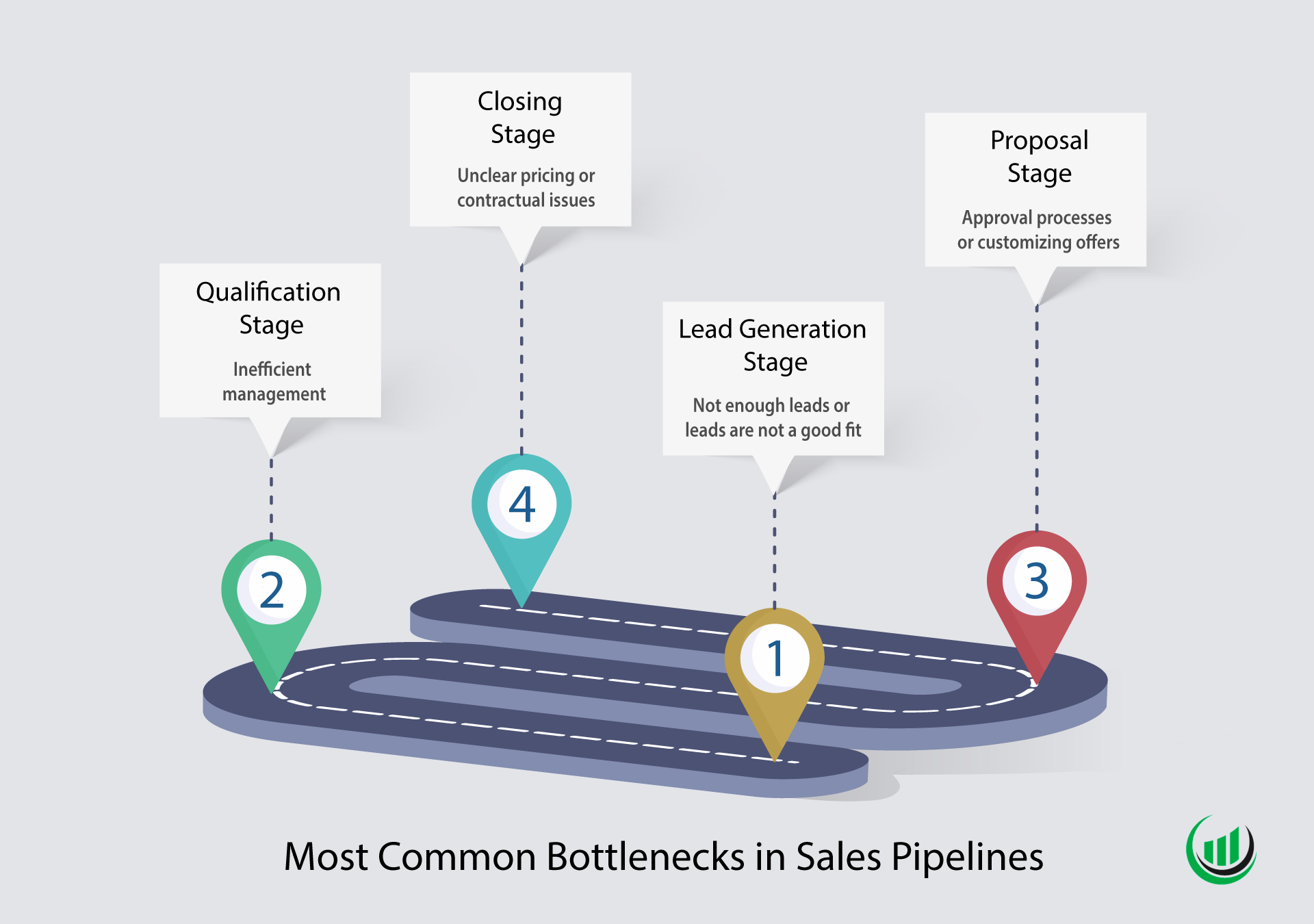Bottlenecks in the sales process are congested points where leads and deals slow down or become stuck. You can refer to them as pitfalls or obstacles, but they always represent critical junctures that affect sales effectiveness, leading to deal delays and missed opportunities.
Bottlenecks interrupt prospects’ flow, impacting conversion rate and extending sales cycle.
Identifying and overcoming bottlenecks is not just removing obstacles, it’s streamlining and enhancing the entire sales pipeline.
Businesses can improve sales velocity by addressing choke points.
Most Common Bottlenecks
A bottleneck can occur in a sales cycle at different points. Each point affects the transition of prospects to paying customers.
Lead Generation Stage
Bottlenecks can happen at the start of the pipeline. This occurs when there are not enough leads or when the leads are not a good fit for the business. The sales team spends excessive time on unqualified leads.
Qualification Stage
A common bottleneck arises during lead qualification. Inefficient management of this stage wastes the sales team’s time. They may spend considerable time on leads with low conversion potential.
Proposal or Negotiation Stage
Bottlenecks sometimes happen in later stages like proposal drafting or negotiations. Delays in these areas can occur for various reasons. There are several reasons for delays in closing deals. Internal approval processes, customer indecision, and customizing offers cause delays.
Closing Stage
Finally, bottlenecks can be found in the closing stage. There are different factors that can cause this situation. These factors include unclear pricing structures, contractual issues, or last-minute sales objections from clients.
How to find Sales Bottlenecks
To identify bottlenecks in your sales process, analyze data, observe, and seek feedback.
Here is how to identify these critical choke points:
Look for deals in the sales pipeline that have unusually long durations. If the time taken to close a deal exceeds the average, it could show a bottleneck.
Additionally, analyze whether there is a specific stage where deals are commonly lost. A noticeable drop in conversion rates between stages often signals the presence of a bottleneck
Sales Rep Feedback
The sales team is on the frontline. They can provide valuable insights. They encounter delays and challenges. Conduct sales meetings focused on identifying process inefficiencies. Encourage brainstorming about difficulties in moving prospects through the pipeline.
Customer Feedback
Ask for feedback from customers about their buying experience. You can learn about delays or frustrations in their journey by asking questions. This helps identify areas in your process that need improvement. Also, review customer complaints and queries. Identify patterns that might show issues in your sales process
Review and Audit
Review and audit your sales process. Compare your sales process with industry best practices to identify potential areas of improvement.
Techniques to Overcome Bottlenecks
To overcome sales process bottlenecks, you need a strategic approach. This approach includes problem-solving, process improvement, and sometimes, a mindset change.
You can apply these techniques to overcome bottlenecks and prevent future ones. Here are some effective techniques:
Process Optimization
Reevaluate and streamline your sales process. Cut unnecessary steps and simplify complex procedures. Sales team can then focus on more critical aspects of sales.
Training and Development
Regularly train your sales team to improve skills, especially in bottleneck-prone areas. Also, encourage the growth of soft skills. Soft skills include negotiation and problem-solving. These skills can help handle challenging stages more effectively.
Resource Allocation
Allocate extra resources, such as employees and technology, to sales stages. These stages often experience bottlenecks and need extra support. Consider hiring specialists for stages of the sales cycle that lack expertise.
Customer Feedback Integration
Incorporate customer feedback into your sales strategy. This will help you understand their needs and preferences better. Then refine your sales approach using insights from customer feedback.
Flexibility and Adaptability
Be open to changing your sales approach based on market trends and customer behavior. The sales team should foster a culture of adaptability. This will help them respond quickly to changing dynamics.
Regular Review
Periodically review the sales process. Identify any new bottlenecks that may arise. The sales team members should report issues and suggest improvements. .
Technology and Tools
Technology and tools are essential for improving and simplifying sales. Implementing the correct technology can reduce bottlenecks. Here are some key aspects to consider:
CRM Software
Companies use CRM tools to manage customer data. They also track sales interactions and track deal progress. Advanced CRM tools automate tasks, set reminders, and provide insights. They give valuable information about customer behavior and sales trends.
Analytics and Reporting
Use analytics tools to gather and analyze data from sales activities. This helps in identifying bottlenecks, understanding customer preferences, and forecasting sales trends. Detailed reporting can aid in making informed decisions and strategizing future sales approaches.
Communication Tools
Adopt effective tools to communicate smoothly within the sales team. Use these tools to interact with clients as well. This includes email, instant messaging, video conferencing, and collaborative platforms.
Lead Generation and Prospecting
Use lead generation software to identify and attract potential customers. Prospecting tools can simplify finding potential customers and prevent unproductive interactions.
Training and E-learning Platforms
Invest in online training platforms to upskill the sales team. You can use these to onboard new members. They teach new sales techniques and keep the team updated on product changes.




